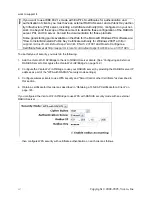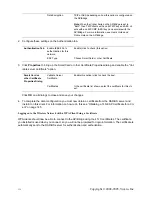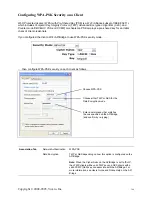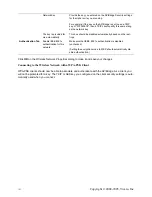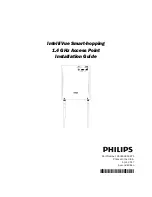
151
Copyright © 2004-2005, Vivato, Inc.
any level of service unless the channel assignments of all of the APs within the coverage area can be
coordinated.
The carrier sense function also applies to non-802.11a/b/g signals. If ANY received signal is of sufficient
level, the carrier sense function will still block Wi-Fi transmission on that channel.
In-Channel 802.11b Signals
As previously stated, other 802.11b devices on the same channel must use CSMA/CA to share the
channel. The greater the number of packets sent by 802.11 devices sharing a channel, the lower the
overall throughput at each device.
Most 802.11a/b/g devices use a single channel at one time and use the direct sequence spread
spectrum (DSSS) method of sending data. However, some home RF devices use frequency hopping,
using either overlapping or non-overlapping channels Frequency hopping interferes with Wi-Fi
operation using DSSS.
Frequency hopping jumps from channel to channel during operation. When non-overlapping
802.11b frequency hopping is used, channels 1, 6, and 11 will be occupied by these signals. The
traffic to/from the AP/Bridge and its clients that are assigned to these channels has to take place
between the periods where a channel is used during the hopping operation. When overlapping
hopping is used, the channels being used will overlap with at least two of the three non-overlapping
channels (1, 6, and 11); effectively limiting the AP/Bridge’s operation to the one remaining non-
overlapped channel and therefore limiting data throughput.
When one of these situations exists, you can do one or more of the following:
•
Pick another RF channel to use that does not interfere with the other system(s).
•
Change the other device’s RF channel number. This may require working with the
administrator or owner of the interfering system. However, agreeing to use separate channels
benefits BOTH systems.
•
Disable the other device.
•
Relocate your AP/Bridge or tilt it down.
Multi-MAC Controller
Because the AP/Bridge has multiple wireless interfaces that can be assigned to the same
channel(s), signals received from a client at one pointing direction may not be detected by the
receiver for another pointing direction. In the example below, clients A and B are both
associated with the AP/Bridge on the same channel, and client B is currently transmitting to the
AP/Bridge. If the wireless interface associating with client A didn’t detect the signal from client
B and began transmitting to client A, it could cause errors in the signal received from client B.

